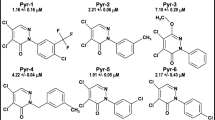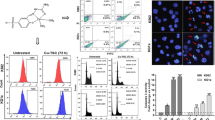Summary
Two novel dichlorophenyl urea compounds, SR4 and SR9, were synthesized in our laboratory and evaluated for anti-cancer activities. Specifically, we investigated the antiproliferative properties of these new compounds on promyelocytic HL-60 leukemia cells by analyzing their effects on cell differentiation, cell cycle progression and apoptosis. SR4 and SR9 were both cytototoxic to HL-60 cells in a dose-and time-dependent manner, with IC50 of 1.2 μM and 2.2 μM, respectively, after 72 h treatment. Both compounds strongly suppressed growth of HL-60 cells by promoting cell cycle arrest at the G0/G1 transition, with concomitant decrease in protein levels of cyclins D1 and E2 and cyclin-dependent kinases (CDK 2 and CDK 4), and increased protein expression of CDK inhibitors p21WAF1/Cip1 and p27Kip1. In addition, either compounds induce cell differentiation as detected by increased NBT staining and expression of CD11b and CD14. Treatment with SR compounds also promoted mitochondrial-dependent apoptosis as confirmed by Annexin V-FITC double staining, DNA fragmentation, increased expression of caspase 3, 7 and 9, cytochrome c release, PARP degradation, and collapse in mitochondrial membrane potential (ΔΨMT). Collectively, these results provide evidence that SR4 and SR9 have the potential for the treatment of human leukemia and merit further investigation as therapeutic agents against other types of cancer.








Similar content being viewed by others
References
Estey E, Döhner H (2006) Acute myeloid leukaemia. The Lancet 368:1894–1907
Jemal A, Siegel R, Xu J, Ward E (2010) Cancer statistics. CA Cancer J Clin 60:277–300
Battistella M, Burry L, Seki JT (2004) Retinoic acid syndrome after one dose of all-transretinoic acid. J Oncol Pharm Pract 10:149–154
Gallagher RE (2002) Retinoic acid resistance in acute promyelocytic leukemia. Leukemia 16:1940–1958
Lee KW, Kim HJ, Lee YS, Park HJ, Choi JW, Ha J, Lee KT (2007) Acteoside inhibits human promyelocytic HL-60 leukemia cell proliferation via inducing cell cycle arrest at G0/G1 phase and differentiation into monocyte. Carcinogenesis 28:1928–1936
Ghobrial IM, Witzig TE, Adjei AA (2005) Targeting apoptosis pathways in cancer therapy. CA Cancer J Clin 55:178–194
Senderowicz AM (2004) Targeting cell cycle and apoptosis for the treatment of human malignancies. Curr Opin Cell Biol 16:670–678
Shapiro GI (2006) Cyclin-dependent kinase pathways as targets for cancer treatment. J Clin Oncol 24:1770–1783
Schwartz GK, Shah MA (2005) Targeting the cell cycle: a new approach to cancer therapy. J Clin Oncol 23:9408–9421
Rahbar S, Figarola JL (2003) Novel inhibitors of advanced glycation endproducts. Arch Biochem Biophys 419:63–79
Budirahardja Y, Gönczy P (2009) Coupling the cell cycle to development. Development 136:2861–2872
Vermeulen K, van Bockstaele DR, Berneman ZN (2003) The cell cycle: a review of regulation, deregulation and therapeutic targets in cancer. Cell Prolif 36:131–149
Besson A, Dowdy SF, Roberts JM (2008) CDK inhibitors: cell cycle regulators and beyond. Dev Cell 14:159–169
Newburger PE, Speier C, Borregaard N et al (1984) Development of the superoxide-generating system during differentiation of the HL-60 human promyelocytic leukemia cell line. J Biol Chem 259:3771–3776
Gorczyca W, Gong J, Ardelt B, Traganos F, Darzynkiewicz Z (1993) The cell cycle related differences in susceptibility of HL-60 cells to apoptosis induced by various antitumor agents. Cancer Res 53:3186–3192
Kroemer G, Galluzzi L, Brenner C (2007) Mitochondrial membrane permeabilization in cell death. Physiol Rev 87:99–163
Henry-Mowatt J, Dive C, Martinou JC, James D (2004) Role of mitochondrial membrane permeabilization in apoptosis and cancer. Oncogene 23:2850–2860
Gottlieb E, Armour SM, Harris MH, Thompson CB (2003) Mitochondrial membrane potential regulates matrix configuration and cytochrome c release during apoptosis. Cell Death Differ 10:709–717
Spierings D, McStay G, Saleh M, Bender C, Chipuk J, Maurer U, Green DR (2005) Connected to death: the (unexpurgated) mitochondrial pathway of apoptosis. Science 310:66–67
Soldani C, Scovassi AI (2002) Poly(ADP-ribose) polymerase-1 cleavage during apoptosis: an update. Apoptosis 7:321–328
Jegham H, Roy J, Maltais R, Desnoyers S, Poirier D (2010) A novel aminosteroid of the 5α-androstane-3α,17β-diol family induces cell cycle arrest and apoptosis in human promyelocytic leukemia HL-60 cells. Invest New Drugs doi:10.1007/s10637-010-9548-6
Wang TH, Wang HS, Soong YK (2000) Paclitaxel-induced cell death: where the cell cycle and apoptosis come together. Cancer 88:2619–2628
Gaul L, Mandl-Weber S, Baumann P, Emmerich B, Schmidmaier R (2007) Bendamustine induces G2 cell cycle arrest and apoptosis in myeloma cells: the role of ATM-Chk2-Cdc25A and ATM-p53-p21-pathways. J Cancer Res Clin Oncol 134:245–253
Schrump DS, Matthews W, Chen GA, Mixon A, Altorki NK (1998) Flavopiridol mediates cell cycle arrest and apoptosis in esophageal cancer cells. Clin Cancer Res 4:2885–2890
Catalano MG, Fortunati N, Pugliese M et al (2005) Valproic acid induces apoptosis and cell cycle arrest in poorly differentiated thyroid cancer cells. J Clin Endocrinol Metab 90:1383–1389
Park M, Lee S (2003) Cell cycle and cancer. J Biochem Mol Biol 36:60–65
Orzáez M, Gortat A, Mondragón L, Bachs O, Pérez-Payá E (2009) ATP-noncompetitive inhibitors of CDK-cyclin complexes. Chem Med Chem 4:19–24
Fischer PM, Lane DP (2000) Inhibitors of cyclin-dependent kinases as anti-cancer therapeutics. Curr Med Chem 7:1213–1245
Ly JD, Grubb DR, Lawen A (2003) The mitochondrial membrane potential (ΔΨm) in apoptosis: an update. Apoptosis 8:115–128
Grimm S, Brdiczka D (2007) The permeability transition pore in cell death. Apoptosis 12:841–855
Lakhani SA, Masud A, Kuida K et al (2006) Caspases 3 and 7: key mediators of mitochondrial events of apoptosis. Science 311:847–851
Terui Y, Furukawa Y, Kikuchi J, Saito M (1995) Apoptosis during HL-60 cell differentiation is closely related to a G0/G1 cell cycle arrest. J Cell Physiol 164:74–84
Yuo A (2001) Differentiation, apoptosis, and function of human immature and mature myeloid cells: intracellular signaling mechanism. Int J Hematol 73:438–452
Otake Y, Sengupta TK, Bandyopadhyay S, Spicer EK, Fernandes DJ (2005) Retinoid-induced apoptosis in HL-60 cells is associated with nucleolin down-regulation and destabilization of Bcl-2 mRNA. Mol Pharmacol 67:319–326
Acknowledgments
The authors are grateful to Jacquelin and Isaac Moradi for their many years of support and research funding. We are also thankful to Mariko Lee and Dr. Brian Armstrong (Microscope Core Lab, COH) and Lucy Brown (Analytical Core Facility, COH) for their technical assistance in microscopy and flow cytometry analyses, respectively.
Conflict of interest
The authors declare that they have no conflict of interest.
Author information
Authors and Affiliations
Corresponding author
Electronic supplementary materials
Below is the link to the electronic supplementary material.
Supplement Fig. 1
SR compounds inhibit growth and proliferation of human leukemia, lung and breast cancer cells. Cancer cells were exposed to various concentrations of SR compounds for 72 h, followed by determination of cell viability using the MTT (leukemia cells) or XTT assay (A-549, MCF-7 and MDA-MB-231 cells). Data expressed as mean ± SE from 3–4 independent experiments. (EPS 1753 kb)
Supplement Fig. 2
NIH/NCI 60 DTP Human Tumor Cell Lines five-dose growth response curve data for SR4. (EPS 2652 kb)
Rights and permissions
About this article
Cite this article
Figarola, J.L., Weng, Y., Lincoln, C. et al. Novel dichlorophenyl urea compounds inhibit proliferation of human leukemia HL-60 cells by inducing cell cycle arrest, differentiation and apoptosis. Invest New Drugs 30, 1413–1425 (2012). https://doi.org/10.1007/s10637-011-9711-8
Received:
Accepted:
Published:
Issue Date:
DOI: https://doi.org/10.1007/s10637-011-9711-8




